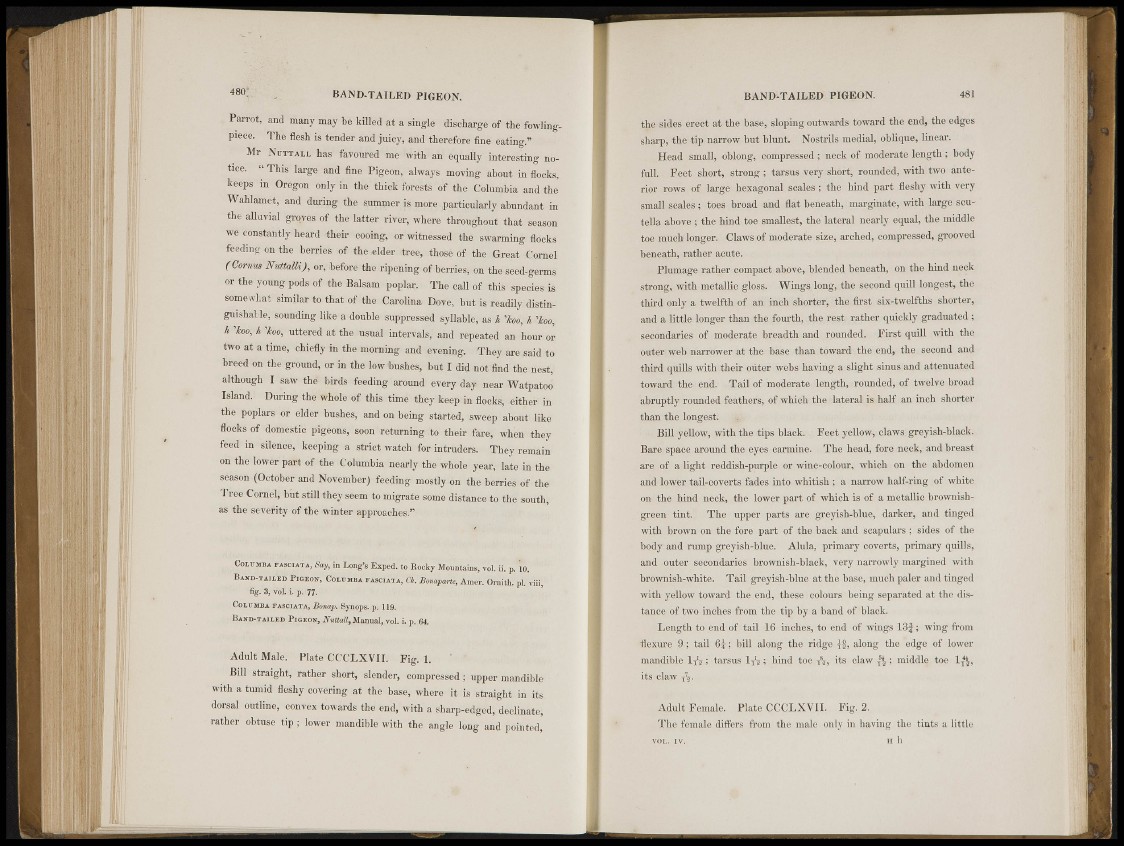
1 BAND-TAILED PIGEON.
Parrots and nitty m a f b è "killed a t a single discharge of the fowling,
pi«®. The flesh is tender and juicy, and therefore fine eating."
Mr »TTAlt has favoured me with an «-qual'h interesting noti<!
0- " T h i s larS e «1« Pigeon, always moving about in flocks,
Keeps in Oregon only in the thiok forests of the Columbia and the
Wahlaaet, aid: during the s.uinuior is more particularly abundant in
the aUuviW groves of the latter river, where throughout that, season
we constantly heard their cooing, or witnessed the swarming flocks
ftéáiiíf on the berries of the .elder tree, those of the Great Cornel
(Gornm N-utfalli), or, .before the ripening ,if berries, on the seed, germs
or'the young1 pods of the Balsa» poplar. The call of ithis species is
somewhat similar to that of the Carolina Dey®, hut is readily distinguishable,
sounding like a double Suppressed syllable, as h h '¡too,
h 'km, /, 'Ho, uttërèâ at the usual intervals, and repeated an hour or
t » o at a time, chiefly in the morning and eveuing. They are said to
breed on the ground,--or in the fojw «bushes, but I did not find the nest,
although I saw the birds feeding around every day. near Watpatoo
Island. : During the whole of this timé th||iheep in flocks, either in
the poplars or older bushes, and on being started, sweep about like
flocks of domestic pigeons, soon r,turning ,to their fare, when they
f é é # i à silence, keeping a strict watcli for intruders. They.remain
on the lower part of th<r>r„|„mbia neariy.:thc whole year, late in the
season (October and November) feeding mostly on the berries of the
Tare Cornel, biit still they seem to migrate »ome distance to the: south,
as the seventy of the winter approaches*'
COLUMBA I'ASCIATA, .Si;/, i n Lorg' s B i p e d , t o R o c k y »oi iuteins , vol. ii. I( 1 . '
TSAJTD-TATLEI. PJUEOU, t'oii.-MHA TASCIATI, <M. Bom^omt, Amo r . Orni th. pL vfii*,*
%. 3, vol. i. p. 77.
COLUMBA FASOIATA, Hi.nnp. -Synops. p. 119.
BAND-TAILED I'JGKOS, .VAF/IIL^.MAMIA:, vol . i . .p. 64.
Adult Male. Plate ©fCLXVI I . Fig. 1.
Bill straight, rather short,'slender, compressed; upper mandible
with a tumid fleshy covering at the base, where it is straight in its.
dorsal outline, convex towards the end, with a sharp-edged, declinate,
rather ObtWse tip; lower mandible with the angle long and pointed,
B A N D - T A I L E D PIGEON. 481
the sides erect at the base, sloping outwards toward the end, the edges
sharp* the tip narrow but blunt. Nostrils medial, oblique, linear.
Head small, oblong, compressed ; neck of moderate length; body
lull. Koct short, strong; tarsus very short, rounded, with two anterior
rows of large hexagonal scales; th.- hind part fleshy with very
small scales;; toes broad and flat beneath, margínate, with large scutella
above ; flic hind too smallest, the lateral nearly equal, the middle
toe much longer. Claws of moderate size, arched, compressed, grooved
beneath, rather acute.
Plumage rather compact above, blended beneath, on the hind neck
strong, withimetallie gloss. Wings, long, the second quill longest, the
third only a twelfth of an inch shorter, the first six-twelfths shorter,
and a little, longer than the fourth, the rest, rather quickly graduated ;
secondaries of moderate breadth and rounded. First quill with the
outer web narrower at the: base than toward the end, the second and
third quills with thei r outer webs having a slight sinus and attenuated
toward the end. Tail' of. moderate length, rounded, of twelve broad
abruptly rounded feathers, of which the lateral is. half an inch shorter
than the longest:
Hill yellow, with the tips black. Feet yellow, claws greyisfeblack.
Bare space around the eyes carminé'. The head, fore neck, and breast
are of a light reddish-purple or wine-colour, which on the abdomen
and lower tail-coverts fades into whitish narrow half-ring of white
on the hind neck, the lower part of Which is of a metallic brownishgreen
tint. The upper parts are greyish^blue, darker, and tinged
with brown on the fore part of the back and scapulars; sides of the
body and ruinp greyish-blue. Alula, primary coverts, primary quills,
and J outer secondaries brownish-black, very narrowly margined with
brownish-white. Tail greyish-blue at the base, much paler and tinged
with yellow toward the end, these • colours being separated at the distance
of two inches from the tip by a band of black.
Length to end of tail 16 inches, to end of wings 13f ; wing from
flexure 9:; tail 64;' feffl along the ridge ij¡, along the edge of lower
mandible 1 f j ; tarsus l ; hind toe its claw ; middle toe
its claw jV
Adult. Female. Plate CCCLXVII. Fig. 2.
The female differs from the male only in having the tints a little
vol.. iv. h h